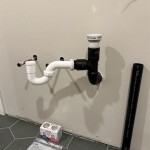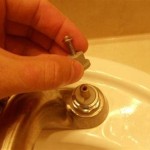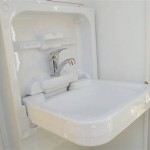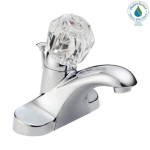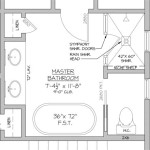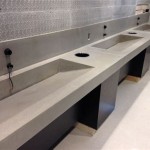Bathroom Vanity Pulling Away From Wall: Causes, Consequences, and Solutions
A bathroom vanity separating from the wall is a common household issue that can manifest in various degrees of severity. It ranges from minor gaps to significant detachments, each indicating underlying problems that require timely attention. Ignoring the issue can lead to further damage, increased repair costs, and potential safety hazards. Understanding the causes, assessing the consequences, and implementing appropriate solutions are crucial for maintaining a functional and aesthetically pleasing bathroom.
The longevity and stability of a bathroom vanity rely heavily on its proper installation and the structural integrity of the surrounding materials. A vanity installed correctly should be securely anchored to the wall studs, capable of withstanding daily use and the weight of the countertop, sink, and stored items. However, various factors can compromise this stability over time, leading to the observed separation.
Common Causes of Vanity Detachment
Several factors can contribute to a bathroom vanity pulling away from the wall. These range from installation errors and water damage to structural issues within the wall itself. Identifying the root cause is essential for selecting the appropriate repair strategy.
Improper Installation: A frequent culprit behind this problem is inadequate installation techniques. This encompasses several potential errors. For instance, failing to locate and secure the vanity to wall studs provides insufficient support. Wall studs are vertical framing members that offer solid anchoring points. If the installer relies solely on drywall anchors, the weight of the vanity and its contents may eventually overwhelm the anchors, causing them to pull out or fail. Furthermore, using the wrong type or size of screws can also compromise the connection between the vanity and the wall. Short screws may not penetrate deep enough into the studs to provide adequate grip, while screws that are too thin may shear under the applied stress.
Another aspect of improper installation relates to the leveling of the vanity. If the floor is uneven, and the vanity is not properly shimmed during installation, undue stress can be placed on the wall connections. This uneven weight distribution can contribute to the vanity pulling away over time.
Water Damage: Bathrooms, by their very nature, are exposed to significant levels of moisture. Leaks from faucets, drains, supply lines, or even excessive condensation can lead to water damage behind the vanity. This moisture can weaken the drywall, wood framing, and adhesives used in the installation. Over time, the weakened materials lose their ability to support the vanity, causing it to detach from the wall. Water damage also promotes the growth of mold and mildew, which further degrades the structural integrity of the surrounding area. Even seemingly small, unnoticed leaks can cause substantial damage over extended periods.
Structural Issues within the Wall: The wall itself may have pre-existing structural problems that contribute to the vanity’s instability. This could include damaged or weakened wall studs due to rot, insect infestation, or previous water damage. In older homes, the framing may have simply deteriorated over time. Additionally, if the drywall is cracked or crumbling, it will provide a poor surface for anchoring the vanity. These structural deficiencies compromise the overall support system, making it more likely that the vanity will pull away from the wall.
Weight Overload: Over time, the weight placed inside and on top of the vanity can exceed its design capacity. Storing heavy items within the vanity cabinets, especially on shelves that are not adequately supported, can put excessive strain on the wall connections. Similarly, placing heavy objects on the countertop can contribute to the problem. The constant pressure exerted by the weight can gradually loosen the anchors and cause the vanity to detach from the wall.
Expansion and Contraction: Fluctuations in temperature and humidity, common in bathrooms, can cause the vanity and the surrounding materials to expand and contract. This constant movement can weaken the connections between the vanity and the wall over time. While this effect is generally minor, it can contribute to the problem, especially when combined with other factors such as improper installation or water damage.
Consequences of Ignoring the Problem
Neglecting a bathroom vanity that is pulling away from the wall can lead to a cascade of increasingly serious problems. These consequences extend beyond mere aesthetic concerns and can impact both the functionality and safety of the bathroom.
Increased Water Damage: A gap between the vanity and the wall provides an access point for water to seep behind the vanity. This exacerbates any existing water damage problems and creates new opportunities for mold and mildew growth. The trapped moisture can further weaken the drywall, framing, and flooring, leading to extensive and costly repairs. Undetected leaks can also cause structural damage to adjacent rooms.
Further Structural Damage: As the vanity continues to pull away, it places increasing stress on the remaining connections and the surrounding wall. This can lead to cracking or crumbling of the drywall, damage to the flooring, and even structural damage to the wall studs. In severe cases, the vanity may eventually collapse completely, causing further damage and potential injury.
Plumbing Issues: The plumbing connections for the sink are typically located behind the vanity. As the vanity pulls away from the wall, it can put stress on these connections, potentially leading to leaks or damage to the pipes. A leaking drainpipe or supply line can cause significant water damage and may require professional plumbing repairs. Furthermore, a shifting vanity can make it difficult to access and repair plumbing issues when they arise.
Health Hazards: The presence of mold and mildew, often associated with water damage behind a detached vanity, poses a significant health hazard. Mold spores can trigger allergic reactions, respiratory problems, and other health issues, especially in individuals with pre-existing conditions. Remediation of mold infestations can be a costly and time-consuming process.
Safety Risks: A detached or unstable vanity can pose a safety risk, particularly for children and the elderly. The vanity may tip over or collapse, causing injury. Additionally, the loose connection can create sharp edges or protruding screws that can cause cuts or scrapes. The instability can also make it difficult to use the sink and countertop safely.
Effective Solutions for Repairing a Detached Vanity
Addressing a bathroom vanity that is pulling away from the wall requires a systematic approach that involves diagnosing the root cause, making necessary repairs, and ensuring proper re-attachment. The complexity of the repair will depend on the severity of the damage and the underlying issues.
Assessment and Preparation: Before undertaking any repairs, it is crucial to thoroughly assess the extent of the damage and identify the underlying cause of the detachment. This involves inspecting the wall behind the vanity for water damage, mold growth, and structural issues. It also requires examining the vanity itself for signs of damage or deterioration. If water damage is suspected, it is essential to address the source of the leak before proceeding with the repair. Gather the necessary tools and materials, including screws, shims, wood filler, sealant, and potentially drywall repair materials. Turn off the water supply to the sink before disconnecting any plumbing.
Repairing Wall Damage: If the drywall is damaged or crumbling, it will need to be repaired before re-attaching the vanity. This may involve patching holes, reinforcing weak areas, or even replacing entire sections of drywall. Use drywall compound to fill in any holes or cracks and sand the surface smooth. If the wall studs are damaged, they may need to be reinforced or replaced. This is a more complex repair that may require the assistance of a professional contractor.
Re-attaching the Vanity: Once the wall is repaired, the vanity can be re-attached to the wall. Locate the wall studs using a stud finder and mark their positions. Use long screws (at least 3 inches) to secure the vanity to the studs. Ensure that the screws are driven straight and tight to provide a secure connection. If the floor is uneven, use shims to level the vanity before tightening the screws. Apply a bead of caulk along the top and sides of the vanity where it meets the wall to seal out moisture and prevent future water damage. Reconnect the plumbing, ensuring that all connections are tight and leak-free.
Reinforcing the Vanity: To prevent future detachment, consider reinforcing the vanity’s connection to the wall. This can be done by adding additional support brackets or by installing a ledger board along the wall below the vanity. The ledger board provides a solid support for the vanity and distributes the weight more evenly. When choosing hardware, opt for stainless steel or coated screws to prevent corrosion. Regularly inspect the area around the vanity for signs of water damage and address any leaks promptly.
Addressing Water Leaks: All sources of moisture must be addressed as a preventative measure. Ensuring proper ventilation in the bathroom is crucial to reduce condensation. Caulking around the sink, countertop, and backsplash will prevent water from seeping behind the vanity. Consider installing a leak detection system that will alert to moisture issues. Regular inspection and maintenance of all bathroom components can prevent water damage and extend the life of the vanity.
A bathroom vanity pulling away from the wall is a problem that requires prompt investigation and repair. By understanding the common causes, appreciating the potential consequences, and implementing effective solutions, one can restore the vanity's stability, prevent further damage, and maintain a safe and functional bathroom environment. When in doubt, consulting a professional contractor is recommended to ensure the repairs are done correctly and to prevent future issues.

Cabinets Pulling Away From Wall

4 Ways To Fix A Gap Between Vanity And Wall

Baseboards Pulling Away From Wall

How To Fix A Gap Between Vanity And Wall Upgradedhome Com

How To Install A Veneto Bath Floating Bathroom Vanity

How To Remove A Bathroom Vanity Budget Dumpster

Tutorial How To Install A Bathroom Vanity The Diy Playbook

Wall Hung Vanities Vs Freestanding What S Right

How To Cut And Modify Vanity Drawers For Plumbing Easy Diy Steps Abbotts At Home

How To Install A Vanity Forbes Home
Related Posts


